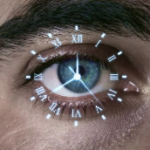About Epiretinal Membranes
 Most of the eye’s interior is filled with vitreous, a gel-like substance containing millions of fibers attached to the surface of the retina (the back of the eye.) As we age, the vitreous can slowly shrink and pull away from the retina. Sometimes when the vitreous pulls away there is microscopic damage to the retina’s surface. When this happens, the retina begins a healing process to the damaged area and forms scar tissue, or an epiretinal membrane. When the scar tissue contracts, it can cause the retina to wrinkle usually without affecting vision. However, if the scar tissue has formed over the macula, the sharp, central vision becomes blurred and distorted.
Most of the eye’s interior is filled with vitreous, a gel-like substance containing millions of fibers attached to the surface of the retina (the back of the eye.) As we age, the vitreous can slowly shrink and pull away from the retina. Sometimes when the vitreous pulls away there is microscopic damage to the retina’s surface. When this happens, the retina begins a healing process to the damaged area and forms scar tissue, or an epiretinal membrane. When the scar tissue contracts, it can cause the retina to wrinkle usually without affecting vision. However, if the scar tissue has formed over the macula, the sharp, central vision becomes blurred and distorted.
Vision loss from an epiretinal membrane can vary from no loss to severe loss. People with an epiretinal membrane may notice their vision is blurry or mildly distorted, and straight lines can appear wavy. Some may have difficulty in seeing fine detail and reading small print. Others may have a gray area in the center of their vision, or perhaps even a blind spot. Over the past 5 years new advances in technology has provided ways in removing epiretinal membranes with excellent results. Dr. David Rabady, a Vitreo -Retinal surgeon at Ophthalmic Consultants of the Capital Region, has trained exclusively using these new technologies and techniques.
If you are experiencing floaters (also treatable), blind spots or notice that fine print is difficult to read– it is important to see an ophthalmologist immediately. Please call us to schedule an appointment at 518-274-3123.

